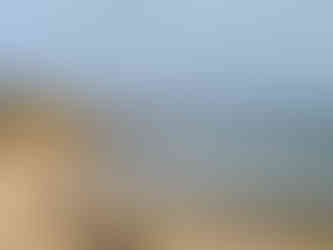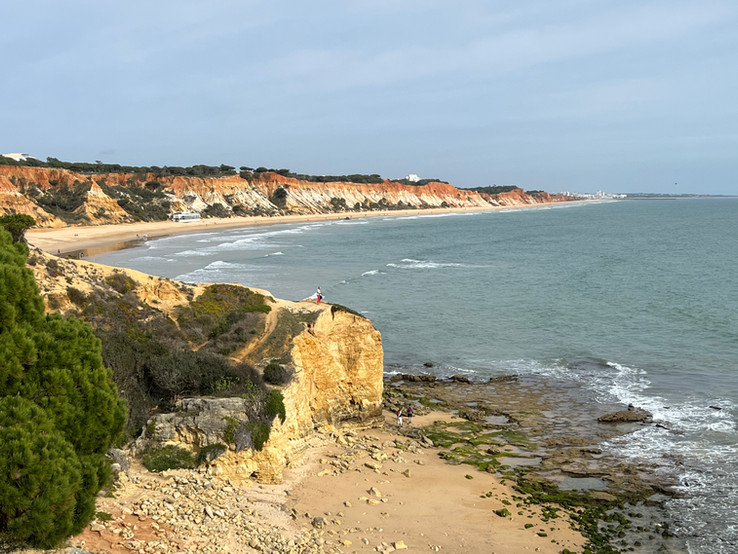The Algarve's western and southern coasts offer spectacular cliffs and pristine sandy beaches (praias), so it is no surprise that year-after-year tourism guides declare them the best in Europe. This post will capture a few of them in images that fail to do them justice. [This post is work in progress]

Praia de Monte Clérigo & Arrifana
This beach, and the adjacent Praia de Amoreira, were recommended by our first Portuguese language teacher. We visited the area on the western Atlantic coastline, near the town of Alzejur, in February 2022. The weather was sunny but cool, with a stiff on-shore breeze. The tides, that are noticeably higher in the winter than the summer, made for spectacular views as waves crashed on the rocks. The roughly six-kilometer hike south along the cliffs from the beach to the Ponta de Atalaia was breathtaking, revealing multiple sandy beaches that are virtually inaccessible from land. At the point, is an archeological site that has uncovered the ruins of a Muslim coastal fortress, Ribat da Arrifana, built around 1130.
[Scroll left/right to view gallery]
Arrifana is a small coastal village a few kilometers south of the ribat. We ate at O Paolo restaurant located on the promontory, affording more breathtaking cliff views. Adjacent to the restaurant are the ruins of another fortress, but this one is Portuguese and dates back to 1635. The sign at its entrance states that the structure was razed by the tsunami that followed the 1755 earthquake. Standing at the fortress's perimeter on the cliff edge, looking at the ocean below -- about 250 feet or 75 meters down -- provides an appreciation of the tidal wave's magnitude and why its devastation was so extensive.
[Scroll left/right to view gallery]
Praia da Bordeira
About 25 km south of Arrifana is the town of Bordeira and the beautiful, expansive beach nearby. We were there in early March on a cloudy day with my niece, Amy, husband Ross, and two daughters, and it was virtually deserted. Like many beaches on the west coast, it is popular with surfers and there is a surf school there. In the summer, it is relatively quiet compared with the southern Algarve beaches that are so popular with tourists.
[Scroll left/right to view gallery]
Praia do Castelejo
Just a few kilometers south of Praia da Bordeira, almost at the southwestern tip of the continent, is Praia do Castelejo. 'Castelejo,' I'm told, means castle but one not occupied by monarchy; that would be 'castelo.' I assume the reason the beach has that name is because of a large rock outcrop that looks a bit like a turret from a certain angle. We discovered this beach during the summer of 2023 and it immediately became one of favorites. Because it is on the Algarve's west coast, it is quite far from the popular resorts on the south coast. So, even in July, the beach was quite empty save for the clients of the several surf schools that favor this beach due to the consistent, mild waves ideal that are for beginners.
The beach stretches perhaps five kilometers but unlike the south coast's sandstone cliffs, the cliffs here are igneous rock. The verticality of rock strata provide evidence of significant earth movement in the past.
[Scroll left/right to view gallery]
Praia da Luz
Just a few kilometers west of Lagos lies the village of Luz and its popular beach. It's possible the name is familiar to you as this fishing village turned tourist destination is connected with the infamous missing person case of Madeleine McCann, the three year-old British girl who was taken from her family's hotel room in 2007 and never found.
While apparently, some insensitive tourists still seek out the hotel, there is much more to enjoy in this lovely beach town. The beach itself offers a sandy expanse as well as rocks worn smooth and laced with tidal pools. The promenade, or calçadão, is lined with shops, restaurants, and bars, most of which offer seating overlooking the shore.
After a semi-strenuous hike up to the top of the cliffs to the east there is an obelisk that is a geomarker but whose original purpose is unclear. A trail follows the coastline and offers magnificent views of the rocks and ocean below. The sandstone and igneous rocks provide beautiful constrasting hues in the setting sun.
[Scroll left/right to view gallery]
Ponta da Piedade & Praias (Pinháo, Dona Ana, Camilo, Pinheiros)
Moving to the Algarve's southern Atlantic coast, at the tip of the Lagos peninsula, is Ponta da Piedade. During the summer of 2021, we drove to Lagos, hiked the trail to the lighthouse, and continued slightly beyond to the end of the promontory. It was a lengthy, undulating walk, along the cliff tops that afforded spectacular views of the beaches, coves, and caves below. It is easy to become blasé about the beauty of Portugal's coastal scenery -- there are just so many picture postcard vistas to enjoy! The gallery below captures (inadequately) shots of the beaches we passed on our hike. Bonus points for spotting the diver; I didn't see him in the frame when I took the picture, just as he was leaping off the cliff!
[Scroll left/right to view gallery]
Praia Grande
Praia Grande is a small beach near Portimão. It is situated on the east bank of the river Arade estuary and so it offers calm waters ideal for kids. We spent a day there with our Amy, Ross and their two young daughters.
[Scroll left/right to view gallery]
Praia do Carvalho Near the popular town of Carvoeiro is this small beach, surrounded by cliffs and with calm water ideal for paddling or swimming. We visited it in the summer of 2019 and reached the sandy beach by descending through a tunnel in the rock. You can take a boat tour of the sea caves that riddle the rocky coastline, including the instantly-recognizable Benagil cave which is close-by. There are few amenities nearby so it is best to bring your own food and drinks. [Scroll left/right to view gallery]
Praia de Albandeira
In the summer of 2024, we drove to check out Praia da Marinha (marine), not far from Carvalho, that had been listed recently in a travel publication as one of the world's top ten beaches. It was mid-July, so the season was in full swing but not yet August-crazy. As we approached the limited parking lot and off-road spillover parking area, it was clear that we weren't the only ones who read the article. It was a zoo and we narrowly avoided getting stuck for hours in a traffic snarl. We decided to try again in the off-season.
Instead, we thought we would try our luck at another beach in the area and drove a few minutes east, stumbling upon Praia de Albandeira, a small beach encircled by cliffs. There was hardly anyone there! Before descending the steps to the sand, we hiked east a kilometer or so along the cliff top and discovered more amazing Algarvian coastline, including the Arco de Bandeleira -- a rock arch accessible from the sea and a popular spot for the many water tours in the area. This section of the Algarve coast is particularly dramatic with several arch structures and caves, including the iconic Benagil cave. [Scroll left/right to view gallery]
Praia dos Arrifes
Continuing east, we found this small beach in one of the many coves along the cliff line. It was the height of the 2021 tourist season (although still not at pre-pandemic levels) so there were plenty of people, although it was not so dense as to be unpleasant. The rocks make an interesting spectacle from the beach, and caves that are only accessible from the ocean attract lots of watercraft. We were fascinated by the Portuguese lady eating what we believe to be limpets (lapas) or goose barnacles (percebes). She pried each one off the rock and ate it raw. She was there 30 minutes or so and must have eaten close to 50.
Praia de Santa Eulália
Just east of Albufeira is the beautiful Santa Eulália beach. It is typical of the Algarve coastline from Sagres to Faro, offering rugged cliffs with sculpted caves and coves in the volcanic rock, and a lovely sandy beach that is very popular during the summer. We spent the best part of a day hiking the cliff trail and enjoyed late-afternoon dinner and drinks at the Atlântico restaurant overlooking the beach.
[Scroll left/right to view gallery]
Praia dos Olhos d'Água
I'm not sure how the 'Eyes of the Water' beach got its name. It is one of many popular beaches on the southern coast that have quaint hamlets of the same name. We usually go to this beach, which is between Santa Eulália to the west and Falésia to the east, to dine at one of its restaurants, O Pássaro Azul (The Blue Bird), overlooking the water.
[Scroll left/right to view gallery]
Praia da Falésia
"Cliff beach" is where we go for our regular walks/runs/swims. Stretching roughly seven kilometers west from the Vilamoura Marina, this flat, expansive, sandy beach is a popular tourist destination in the summer months. We like to time our walks/runs when the tide is low because the damp but firm sand provides a perfectly flat, low-impact surface. The sculptured red sandstone cliffs give the beach its name and there is a rugged, undulating trail along the cliff edge that provides wonderful ocean views (as well as a challenging walk or run). The 'Shark Fin' bush on the cliff's edge is a useful landmark. The photographs below show the stark difference between the number of beachgoers during the season and off-season months. Falésia is a favorite of locals and tourists alike, and as recently as February 2024 it received The Travellers’ Choice Award for the Best of the Best Beaches in the world, awarded based on the high volume of above-and-beyond reviews and opinions from the Tripadvisor community over a 12-month period.
[Scroll left/right to view gallery]
















































































































































































































































































































































Comments